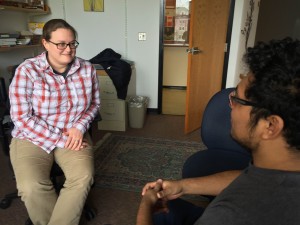How did you get interested in applying mathematics to ecology?
When I was applying for college, I had to apply to a major before I went to college. I was looking through the majors, and I saw applied math, and I thought, “Not bad. Check.” Later my professor said, “Well, why don’t you think about applications of math to biology?” When I went to grad school, I tried out neurobiology, microbial biology, and molecular biology, and finally ecology again and loved it.
Did you do any research as an undergraduate?
Yes. When I was an undergrad, I did two REUs [Research Experiences for Undergraduates]. The first one was based on immunology. I took a class and did some research on a topic. The following summer I was in the Math and Theoretical Biology Institute, where I studied spatial spread of influenza. That was my first encounter with math and ecology. That’s what planted the seed in my head, but it took me a while to determine that I wanted to pursue it.
What are you currently researching?
I am working with an undergrad, Alex Meyer, on spatial synchrony of cicadas. Cicadas are insects that feed off of the roots of trees and live underground for sixteen years. On their seventeenth year, they emerge in huge numbers, reproduce and die, starting the cycle again. It’s amazing that cicadas emerge simultaneously. The other thing is that…[there is] usually one brood is in each location. There is no coexistence of the two broods [in the same place]. What we’re trying to do is to understand how that happened evolutionarily.
What was your most difficult moment as a mathematician?
My most difficult moment was making the decision of where I wanted to go. The places I had been to, prior to Williams, were big research universities where people tended to go once they found a permanent job. I assumed that was what I wanted, and I thought that I would follow this common trajectory. It became clear over time that I wanted to be in a small liberal arts college. Telling my mentors and the people I worked with that I was not going to follow the common path was challenging and nerve wracking.
What was your favorite class in college?
Differential equations. That was the subject that really got me most excited about math. On a very foundational level, it is the basis of all of the work I do, and I loved learning about it. The class gave me a clear direction to pursue math.
Do you have any advice for other mathematicians?
Use your resources. Talk to people. One thing I wished I did more was talk to people about the different options, because I assumed there was only one direction that everyone took. Even though I wasn’t completely satisfied with that one direction, I didn’t ask people about alternatives. It took me a long time to figure it out on my own.
Julie Blackwood is Assistant Professor of Mathematics at Williams College. She hails from the great city of Buffalo, NY and enjoys spending time with her daughter.

